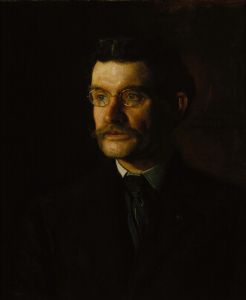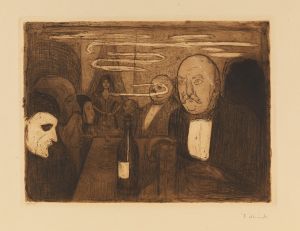
The Pathetic Song
A hand-painted replica of Thomas Eakins’s masterpiece The Pathetic Song, meticulously crafted by professional artists to capture the true essence of the original. Each piece is created with museum-quality canvas and rare mineral pigments, carefully painted by experienced artists with delicate brushstrokes and rich, layered colors to perfectly recreate the texture of the original artwork. Unlike machine-printed reproductions, this hand-painted version brings the painting to life, infused with the artist’s emotions and skill in every stroke. Whether for personal collection or home decoration, it instantly elevates the artistic atmosphere of any space.
Thomas Eakins, an influential American artist known for his realistic portrayals and dedication to capturing the human form, created "The Pathetic Song" in 1881. This painting is a significant example of Eakins' commitment to realism and his interest in the interplay between music and emotion. Eakins, who was deeply invested in the study of anatomy and the human figure, often explored themes of music and performance in his work, reflecting his belief in the interconnectedness of the arts.
"The Pathetic Song" depicts a domestic scene centered around a musical performance. The composition features a woman seated at a piano, engrossed in her music, while a man stands beside her, seemingly absorbed in the melody. The setting is intimate, suggesting a private concert or a moment of shared emotional experience. Eakins' attention to detail is evident in the rendering of the piano, the sheet music, and the figures' expressions, which convey a sense of melancholy and introspection.
Eakins' use of light and shadow in "The Pathetic Song" enhances the emotional depth of the scene. The soft illumination highlights the woman's focused expression and the man's contemplative demeanor, creating a mood that resonates with the painting's title. This careful manipulation of light is characteristic of Eakins' style, which often emphasizes the psychological dimensions of his subjects.
The painting is also notable for its composition and use of space. Eakins employs a balanced arrangement, with the piano and figures occupying the foreground, while the background remains understated, drawing the viewer's attention to the central interaction. This compositional choice underscores the intimacy of the moment and the emotional connection between the figures.
"The Pathetic Song" reflects Eakins' broader artistic interests and his commitment to depicting contemporary life with authenticity and emotional resonance. His focus on music as a theme is consistent with his other works from this period, which often explore the relationship between art, science, and human experience. Eakins' dedication to realism and his innovative approach to composition and lighting have earned him a lasting place in the canon of American art.
Today, "The Pathetic Song" is held in the collection of the Pennsylvania Academy of the Fine Arts in Philadelphia, where Eakins spent much of his career as both a student and a teacher. The painting continues to be appreciated for its technical skill and its poignant exploration of the emotional power of music. Through works like "The Pathetic Song," Thomas Eakins has left an enduring legacy that continues to influence artists and captivate audiences.


















